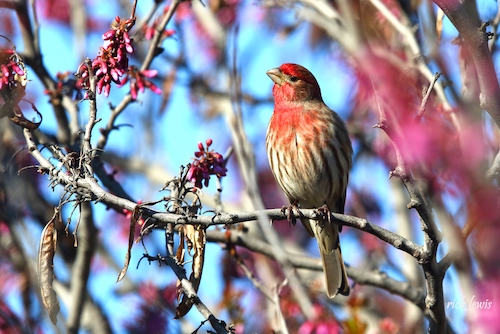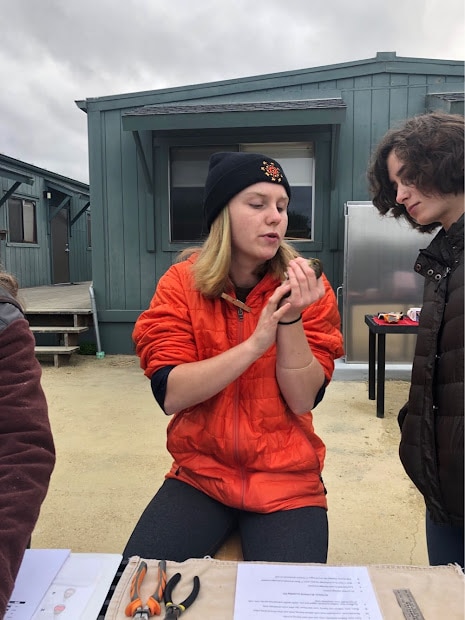Being a Bird Ambassador
By Margaret Hetherwick
Donna Hayes, Audubon member and resident birder of San Francisco’s Bernal Heights district, remembers seeing the glowing face of inspiration when a guest to her office noticed his first bird.
Hayes was a counselor at a city college at the time and was meeting with a student who had brought along their young son. There was a bird feeder outside her window — nothing special, said Hayes, just a regular backyard mix. As the two spoke, the meeting was beginning to drag for the youngest attendee.
“He was sitting there, deathly bored, and a male House Finch came to the birdfeeder,” said Hayes. “The little boy jumped up and exclaimed, ‘Look at that! What is that! It’s so beautiful!’ “I would have given my birdfeeder to him right then.”

This is the crucial moment at which a bird enthusiast becomes a bird ambassador.
Hayes stopped the meeting to tell the boy about the finch as well as show him pictures of other local birds in the area. For the rest of the meeting, he pointed out every visitor to the feeder with fascination. As Hayes waved goodbye, she knew she had been part of a really special moment.
“Maybe after that one incident, I’ve wondered if that ignited something in him. I wish I could know. It was quite something.” said Hayes.
This interaction, while minute in size and innocuous in nature for an experienced birder like Donna Hayes, made all the difference to the child — he was struck by the natural world, and with Hayes’ guidance, forged a connection to his environment. By reinforcing his curiosity and sharing her own knowledge with enthusiasm, Hayes became, spontaneously in that moment, an ambassador for the world of birds.
This role is not exclusive to the world of birding; when one takes on a hobby, it is a given that their interest in that subject will be greater than that of a layperson. One can expect to find themselves fielding questions about their hobby when making small talk. Being a bird ambassador goes beyond sharing details about one’s interests; it is acting as a liaison between the technical and scientific world of bird observation and the inquisitive mind at hand.

Derek Heins, renowned birder in the East Bay and chapter board member of Golden Gate Bird Alliance since June, has observed an uptick in engagement by the general public. He attributes much of this newfound interest to apps like eBird and Merlin — both of which are global databases of real-time observations, used by researchers and amateurs alike. As birding tools and knowledge become readily available, bird ambassadors find themselves easily explaining their deductive process.
“Between eBird, and all the data you can get from that, and newspaper articles about birds every four days, there’s just so much information.” said Heins. “People are using apps before field guides. It takes out the frustration, and I think that’s really big.”
Heins concurred that reducing barriers to the technical knowledge of birding has certainly opened the doors to getting more people involved. Since he started in the mid-1970’s, Heins noted that previously, the only way he could have met other birders was through Audubon’s organized events. These days, not only is he seeing birders everywhere, but people are more curious, too.
“There are 10 times as many birders, serious birders. And not to mention casual people — people who ask, ‘What are you looking at?’ Or, ‘Oh, I saw a hawk!’” Heins said. “Thirty years ago, old ladies were birdwatchers, old white people. It’s become less stigmatized […] people are more accepting of so many more things these days.”
For Derek Heins, being a bird ambassador to a now-receptive audience has become integral to his birding experience. Some, like local birder Eric Schroeder, president of the Board of Directors at Golden Gate Bird Alliance, have been working to get people involved since the beginning of their career.
Schroeder taught at UC Davis for thirty years and made sure that he imparted at least a few pearls of bird knowledge to his students each term. On field trips, he would have students keep lists of mammals and birds they’d observe. To his surprise, toward the end of his time teaching, he started to notice the same trend as Derek Heins — and largely the same causation.
“[These outings] really opened me up to think about the ways in which people bird, and how different things work for different people. I think social media really has become a hub connecting a lot of younger generation birders and people who felt excluded from birding in the past.” said Schroeder. “And not just eBird — there’s all kinds of Facebook groups and so on. Social media has been a boon for birding.”
Schroeder has found that with a welcoming demeanor and the right bird discovery, birdwatching — and subsequently all of nature — become a lot less daunting. He sees the most success when people approach birding as an opportunity to collaborate.
“It’s like writing, […] it’s a social activity. People say writing is the most lonely thing, but when I used to teach, I would make sure I put students in small groups of other students.” he said. “They uplift each other, make each other better. I see birding the same way — for me at least, it’s nicer that way.”
Donna Hayes of Bernal Heights takes the message of collaborative birding to heart. She recalls an evening when a large flock of crows, perhaps 20-30 of them, had been mobbing a raptor in the area, and successfully chased it out of the park. Donna observed none of this — it was recounted to her by other park-goers who saw her binoculars, knew she was a birder, and felt comfortable approaching her to share what they saw.
Donna Hayes knows that encouraging someone’s interest in exploring the outdoors, in any capacity, is invaluable; for her, it’s a human right.
“To be able to go out, and have the quiet, access to trees and non man-made structure around you is something that makes you human. It goes beyond age.” she said. “Everybody benefits from having access to nature. I think it’s imperative.”
On a personal level, I relish opportunities to act as a bird ambassador because I get to practice teaching science, my own birding skills, and human kindness all in the same sentence. Usually, my jurisdiction involves poring over grainy pictures of birds from friends, sharing my best guesses and meeting the friend at their level of interest. I’ve gotten a few people really hooked on birds this way. Knowing people around me can trust me with their curiosity, and that we may bond over our habitat in motion, feeds my confidence like a log feeds mycelium.
